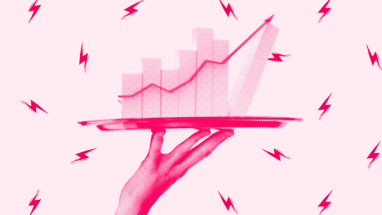According to ProfitWell research, the average SaaS company spends 6 hours defining its SaaS pricing strategy. When you read our article, you will quickly realize that it is not enough.
You have certainly worked hard and long to develop your software (and well done). But without a good pricing strategy, it is most likely that you will only have limited success. Monetizing your service is a lever that needs to be exploited to its full potential to maximize your revenue.
Finding the right price for your SaaS software is delicate. There is no one fits all recipe, that works every time, but there are a few good practices that we will reveal in this article.
Why is SaaS pricing more strategic than you think?
Pricing is a determining factor when choosing software programs.In SaaS, as in other areas, price is not just an amount that is spent, but a real strategic choice.Firstly, it is a decisive element in triggering the decision process to subscribe to one SaaS rather than another, because:It is discriminating: some companies, particularly those with limited financial resources, will directly eliminate subscriptions that do not fit into their budget from their research.It defines your positions in the market in relation to your competitors: it gives a certain idea of the value of your offer and your expertise to prospects. So you need to be consistent if you want to reach your core audience.It can give you a competitive advantage: if your different offers and pricing are clearly defined and displayed (we'll see this a little later in the article).☝️ What are the consequences of poor pricing?
A price that is not high enough
- it makes you lose money, and then it will be much more difficult to raise it without a good reason to do so. If you do, you’ll risk disappointing your customers.
A price that is too high
- it discourages buyers if established players charge these prices: you will automatically be categorized as too expensive without a certain level of recognition,
- it is disappointing if your software does not live up to the expectations generated by a certain price.
Pricing, a growth opportunity in its own right
When you want to increase your revenues, you tend to use the lever of acquiring new customers.However, the lever of monetization is much more powerful. According to a ProfitWell study conducted on more than 500 SaaS companies, using the monetization lever is four times more effective in terms of increasing revenue than acquisition - it's worth looking into, isn't it?To understand this, you need to look at the ratio between customer life value and customer acquisition cost:
- a ratio greater than 1 means that you don't lose money when you sell your products,
- the further the ratio is from 1, the faster you create value.
🤑 According to the same study, companies that review their pricing once a year have a ratio that is 3 times higher than those who don't, and those who are in a continuous improvement process of their pricing, it is 10 times higher.
5 SaaS pricing models to try
Flat rate pricing
Also known as flat rate, this pricing model works on the basis of a single price (monthly or annual), the same features and service levels for all, regardless of the number of users.The advantages:
- users do not have to restrict the use of the software internally (especially when they have many employees),
- they have access to all the features your application can provide.
On the other hand, some small companies will not be happy, paying for features they don't need, pushing them to choose a package more suited to their needs from the competition.Result: For you, it is an easy model to manage:
- a single offer is easy to understand and sell,
- it will be easier to calculate your projected turnover via your MRR (monthly recurring revenue) or ARR (annual recurring revenue),
- The resulting strategic decisions will be much easier.
The downside of the one-size-fits-all offer is that you are limiting the expansion of your turnover, as it will not be suitable for everyone. Either because the service is not premium enough for some, or because the tool will be too cumbersome for the needs of others.
Rate per user
This pricing model is widely used in the SaaS field. Based on the same principle of simplicity and transparency as the fixed price, it can however be adapted to different company sizes proportionally.Thus, your solution will be more accessible to a very small company or a freelancer than a fixed price, which is probably higher, while allowing them to benefit from all the features of your tool. On your side, you keep the ability to quickly calculate your projected revenues.This cost per user, or per seat, has a few drawbacks, however:
- You risk losing large companies with a very high number of users along the way. In this case, they will prefer to go to the competition, which offers a single rate regardless of the number of users.
- They will tend to limit their use to a few users to avoid paying too much, slowing down the expansion of your revenues and your reputation.
💡The good idea
There is a variation of this model, which is active user pricing. Used in particular by Slack, it allows the customer to register as many users as possible, while having the guarantee that only active users will actually be invoiced. In this way, the invoice is automatically adapted to usage. A good in-between solution to convince companies with a volatile user base!
Pay-as-you-go pricing
This pricing model makes the customer pay according to his consumption.This may concern the consumption of :
- certain optional features,
- storage volume
- amount of emails sent
- amount of pages scanned, etc.
Advantage: this model can be adapted to many parameters, and is particularly suitable for companies whose usage varies each month.Disadvantage: as users only pay for what they use, it will be difficult for you to make accurate turnover forecasts.
Feature packs
This pricing model, which is increasingly used, aims to define several offers in the form of feature packages, for different types of user needs, and at different prices. We'll see why later in the article, but keep in mind that you should avoid proposing more than 4 different offers to avoid losing potential buyers.Advantage: what is interesting about these packages is that they clearly indicate the offers; you can quickly see what the package of the higher level offers in addition to the previous one. But what allows prospects to make a choice and take action is the comparison. By defining packages, you create a reference system that is specific to you, allowing the customer to compare your offers so well that they almost forget to compare you to your competitors.Disadvantage: this type of pricing requires a lot of work upstream to define your marketing personas. To define your offers perfectly, you will need to gather a certain type of information, such as:
- the essential features,
- the features or services that generate the most value,
- the price your persona is willing to pay for them, etc.
This is by far our favorite pricing model! Don't hesitate to regularly ask your customers about their expectations to make your packages evolve in the right direction.
Freemium model
This fairly popular pricing model consists of offering a free entry-level product, with the possibility of adding additional paid feature packs later on. The idea is to remove the obstacles to the discovery of your product, while allowing these free users to gradually move on to paying.The free version must be subtly put together, it must be both :
- sufficiently developed and qualitative to convince users to try it,
- limited so as to be seduced by paying options, which are difficult to resist.
It is therefore possible to make a feature accessible, but limit the number of uses, or to block access to features.Advantage: it makes it possible to use your software without having to pay. Your prospects will be more inclined to test your solution independently to make up their own minds and see if the product meets their needs.If your offer is well constructed and your product good, they will subscribe to your paying options.
7 psychological techniques for setting a price that converts
The reference price
Everything in life is subjective, and this is especially true when it comes to prices. Everyone, depending on his or her point of view and experience, may judge the same price as high or low.This technique, also known as price anchoring, is based on the principle that the first advertised price will always serve as a reference point. If you are confronted with a lower price later on, you will be more inclined to make a purchase, because in comparison with the first price, your brain will judge that it is a good deal.Example: restaurants use this trick on the menus in front of their businesses. They put a high-priced dish in front of the menu to make the rest of the menu look more affordable.In the example below, the Convert software places one offer excessively higher than the other two. When you see a price tag of nearly $8,000 per month, you sweat a lot less about spending "only" $500.
The magic number 9
Have you noticed that sales prices more often end in 9 than in 0?This well-known psychological lever is also used in the field of SaaS. When our brain ‘reads’ a number, it tends to retain the one on the left first. Thus, 499 euros is imprinted in the brain as 400, rather than 500.The marketplace Gumroad conducted a study of transactions on its site and found that conversion rates are significantly higher on prices ending in 9 vs. 0.The results are clear.
The reduced price
This consists of displaying the initial price of a product before reduction. The brain will automatically associate the value of the product with the premium price while paying a lower rate, similar to the principle of the reference price.However, this lever should be used with great caution, as it can blur the perception of the value of your product and negatively impact your business.☝️ProfitWell studied the impact of discounts among 88 SaaS companies. It found that overly aggressive discounting increases the churn rate and decreases the customer lifespan.We therefore advise you to keep discounts as the ultimate sales argument for your sales staff, and for annual subscriptions.
The trial price
This involves offering a low price for a limited period to encourage prospects to subscribe to your service.Even if the price goes up afterwards, it allows them to try it out at a lower cost to ensure that your software meets their needs and that the value provided matches the price. Those who are won over will be happy to pay the real price to continue using your services!The advantage over a free trial, even if the price is very low, is that testers have to enter their bank details, which is one of the most difficult psychological barriers to overcome. It will then be easier to get them to use their credit card.
Eliminating the paradox of choice
The paradox of choice can be summarized as follows: too many choices kill the purchasing process. When you go looking for the ideal software and you have to compare dozens of software products, with dozens of offers and hundreds of features, you can quickly find yourself lost and unable to make a decision.To prevent your prospects from being stuck in front of your offers, make it easy for them to make a decision. In the field of SaaS, it is estimated that the software that converts best has between 3 and 4 offers maximum.
The decoy offer
This involves marketing an offer at such an absurd price that the others will seem reasonable. The aim is not to sell this decoy offer, but to use it to enhance the value of the others.For example, if out of three offers you make, two are at the same price and one of them has extra options, chances are that the decoy offer will sway your choice towards the higher option rather than the entry-level one.
The middle price
In the minds of consumers, the price in the middle is seen as the most popular and clever choice: not too expensive, not low-end, enough features without unnecessary services, etc. In other words, it is seen as the most popular choice. In other words, it is considered the least risky option and therefore the most often subscribed to!Some SaaS software packages play on this lever by highlighting the middle offer even more, with a colored CTA, more information, etc.It immediately catches the eye.
Carefully presenting offers to trigger purchases
There was a time, not so long ago, when prices were touchy subjects, a delicate issue. Salespeople only discussed it at the very end of their customer calls, after making sure they had highlighted all the qualities of the software.The democratization of SaaS, and therefore of subscription-based offers, has changed the situation somewhat. So much so that price has become a commercial and sales asset in its own right. Moreover, the prices have their own dedicated page on the website.We would even go so far as to say that this page is the most important one on your website (no less). Why is that? Simply because it is the one that will convert your prospects into customers, or not.For each offer, you absolutely must show these three elements:
- Who the offer is for,
- the key features,
- the price.
Is that all? Yes. You can also highlight the monthly price for an annual subscription, which is often more advantageous. An element that can weigh in the balance of the choice, and thus increase your income.As far as design is concerned, take care of it as much (or even more) than your other pages. Keep in mind, the idea is to create a showcase that will highlight your packages. Present each of them in a column, play with transparency on the content, use color and attractive CTAs.
When is the right time to change your pricing?
As we've seen, optimizing your pricing on a regular basis ensures better performance for your business. But it is not a trivial matter for your customers.So make sure you :
- "justify" the new amounts in case of price increases, for example
- the addition of new features or modules
- a total redesign of the site with a different and improved user experience;
- revise your offers by creating new packages to define a new benchmark;
- do not overdo the changes, customers must be able to find their way around and not see their bills increase too often.
As for the timing, it is best to avoid changing the price too quickly after the launch of your software. You risk giving off an amateurish image. Wait until you have a sufficient customer base that allows you to lose some customers without jeopardising your business!
So, now that you know all of this, when are you going to review your pricing strategy?




